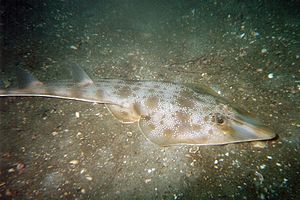Rhinobatidae
| Rhinobatidae | ||||||||||||
|---|---|---|---|---|---|---|---|---|---|---|---|---|

Pseudobatos lentiginosus |
||||||||||||
| Systematics | ||||||||||||
|
||||||||||||
| Scientific name | ||||||||||||
| Rhinobatidae | ||||||||||||
| Bonaparte , 1835 |
The Rhinobatidae are a family of the rays (Batoidea). Most species of the so-called violin or guitar rays belong to the family.
features
The species of Rhinobatidae are small to medium-sized rays with a maximum length of 1.7 meters. The trunk is strongly flattened, the body disc consisting of trunk and pectoral fins is wedge-shaped or shovel-shaped. The pelvic fins are clearly behind the body disc. The rostrum is often elongated and pointed or rounded in front. The eyes and injection holes are medium to large in size, the injection holes have one or two skin folds. The nostrils are short and sloping, the anterior nasal valves are often very wide and often fused together in the middle. The mouth is straight or slightly curved. The skin of the fish is usually covered with small scales of placoid, but sometimes it is also unscaled. A row of small thorns runs along the center line of the back, fields of small thorns are near the eyes, on the muzzle and on the "shoulders". The tail is flattened and has a longitudinal fold of skin in the lower part of both sides. Both folds of skin meet at the base of the poorly developed lower caudal fin lobe. The caudal fin is small. The two dorsal fins are clearly separated and lie behind the end of the pelvic fins.
The rays are usually gray or brownish in color on their upper side, monochrome or patterned with lines, bars or spots. The edges of the skull and the cartilage of the rostrum are usually not sharply delineated from the muzzle. The ventral side is mainly white, black spots are sometimes present on the underside of the snout.
Systematics
The Rhinobatidae family was introduced in 1835 by the French biologist Charles Lucien Bonaparte . In most cases it was viewed as a group of primeval rays that stand at the beginning of the ray tree and they were placed in a separate order, assigned to the Rhinobatiformes or the Rajiformes . Today it is certain that the Rhinobatidae in their original composition in which they included almost all violin or guitar rays, were a paraphyletic group, i.e. In other words, although they go back to a common ancestral form, the taxon does not include all forms derived from this ancestral form. The sawfish (Pristidae) stand deep within the fiddle rays. For this clade, which is the sister group of the stingray species (Myliobatiformes), the new order name Rhinopristiformes was introduced in 2016 .
Genera and species
- Genus Acroteriobatus Giltay, 1928
- Acroteriobatus annulatus (Müller & Henle, 1841)
- Acroteriobatus blochii (Müller & Henle, 1841)
- Acroteriobatus leucospilus (Norman, 1926)
- Acroteriobatus ocellatus (Norman, 1926)
- Acroteriobatus omanensis Last et al., 2016
- Acroteriobatus salalah (Randall & Compagno, 1995)
- Acroteriobatus variegatus (Nair & Lal Mohan, 1973)
- Acroteriobatus zanzibarensis (Norman, 1926)
- Genus Pseudobatos Last , Séret & Naylor, 2016
- Pseudobatos buthi Rutledge, 2019
- Pseudobatos glaucostigmus ( Jordan & Gilbert, 1883)
- Pseudobatos horkelii (Müller & Henle, 1841)
- Pseudobatos lentiginosus ( Garman , 1880)
- Pseudobatos leucorhynchus ( Günther , 1867)
- Pseudobatos percellens ( Walbaum , 1792)
- Pseudobatos planiceps ( Garman , 1880)
- Pseudobatos prahli (Acero P. & Franke, 1995)
- Pacific fiddle ray ( Pseudobatos productus ) ( Ayres , 1854)
- Genus Rhinobatos Linck, 1790
 Common fiddle ray ( Rhinobatos rhinobatos )
Common fiddle ray ( Rhinobatos rhinobatos )- Rhinobatos albomaculatus Norman, 1930
- Rhinobatos annandalei Norman, 1926
- Rhinobatos austini Ebert & Gon, 2017
- Rhinobatos borneensis Last, Séret & Naylor, 2016
- Rhinobatos holcorhynchus Norman, 1922
- Rhinobatos hynnicephalus Richardson , 1846
- Rhinobatos irvinei Norman, 1931
- Rhinobatos jimbaranensis Last, White & Fahmi, 2006
- Rhinobatos lionotus Norman, 1926
- Rhinobatos manai White et al., 2016
- Rhinobatos nudidorsalis Last, Compagno & Nakaya, 2004
- Rhinobatos penggali Last, White & Fahmi, 2006
- Red sea fiddle ray ( Rhinobatos punctifer ) Compagno & Randall, 1987
- Rhinobatos ranongensis Last et al., 2019
- Common fiddle ray ( Rhinobatos rhinobatos ) ( Linnaeus , 1758)
- Rhinobatos sainsburyi Last, 2004
- Schlegel's fiddle ray ( Rhinobatos schlegelii ) Müller & Henle, 1841
- Rhinobatos whitei Last, Corrigan & Naylor, 2014
literature
- Last, PR, Séret, B. & Naylor, GJP (2016): A new species of guitarfish, Rhinobatos borneensis sp. nov. with a redefinition of the family-level classification in the order Rhinopristiformes (Chondrichthyes: Batoidea). Zootaxa , Vol 4117, No 4: 451-475. DOI: 10.11646 / zootaxa.4117.4.1
Web links
- Rhinobatidae on Fishbase.org (English)

